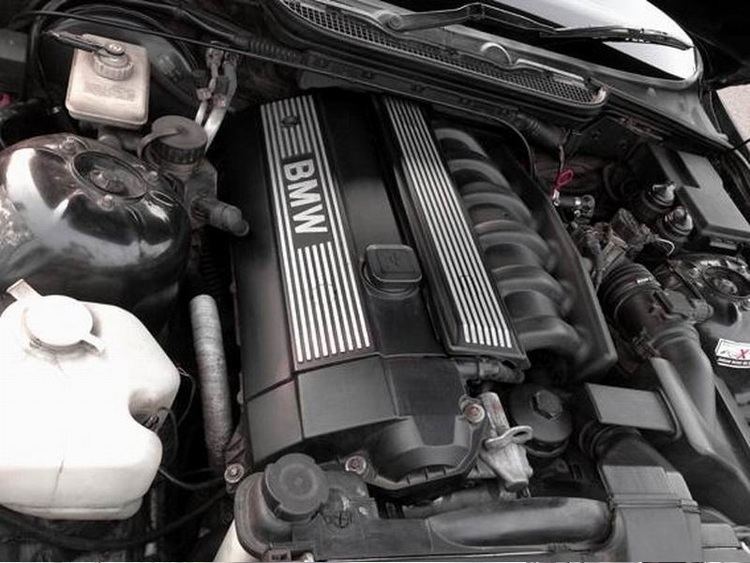Production 1994–2000 Predecessor BMW M50 | Configuration Straight-6 Successor BMW M54 | |
 | ||
Manufacturer BMW, Bayerische Motoren Werke AG | ||
The BMW M52 is a straight-6 DOHC piston engine which was produced from 1994-2000. It was released in the E36 320i, to replace the M50. It was replaced by the M54 engine.
Contents
- M52B20
- M52TUB20
- M52TUB24
- M52B25
- M52TUB25
- M52B28
- M52TUB28
- Nikasil problems with high sulfur fuels
- S52 North American Market
- References
Compared with its M50 predecessor, the M52 uses an aluminium block. However, North American models used iron blocks instead (except in the Z3), therefore the North American M52 is more akin to the M50TU. Like the M50TU, the M52 uses variable valve timing on the intake camshaft (called single VANOS by BMW).
In 1998, the M52TU ("technical update") was released, adding variable valve timing to the exhaust camshaft (called dual VANOS by BMW). Other upgrades included electronic throttle control (which uses a throttle cable as backup), a dual length intake manifold (called "DISA" by BMW) and revised cylinder liners.
The M52 and S52 engines were on the Ward's 10 Best Engines list from 1997 to 2000.
The S52 engine is used in USA versions of the 1996-1999 E36 M3 and the 1998-2000 Z3M. This engine is a tuned version of the M52 engine, as opposed to the S50 engine used for these cars in other markets.
M52B20
A 1,991 cc (121 cu in) version was introduced in 1994. Bore is 80 mm (3.1 in) and stroke is 66 mm (2.6 in).
Applications:
M52TUB20
The "technical update" in 1998 included dual VANOS, which improved low rpm torque.
Applications:
M52TUB24
2.4 L. For Thai market only.
M52B25
A 2,494 cc (152 cu in) version introduced in 1995. It produces 125 kW (168 hp). Bore is 84 mm (3.3 in) and stroke 75 mm (3.0 in).
Applications:
M52TUB25
The "technical update" in 1998 included dual VANOS, which improved low rpm torque.
Applications:
M52B28
The 2,793 cc (170 cu in) version of the M52 debuted in 1995. It has a bore of 84 mm (3.3 in), a stroke of 84 mm (3.3 in) and produces 142 kW (190 hp).
Applications:
M52TUB28
The "technical update" in 1998 included dual VANOS, which improved low rpm torque.
Applications:
Nikasil problems with high sulfur fuels
The aluminum M52 engine received criticism in some markets with high levels of sulfur in the petrol during the late 1990s. Sulfur has a corrosive effect on Nikasil and led to many early M52 and M60 engines having premature bore-liner wear. In the USA, the M52 used an iron block (except for the M52B28 in the Z3 which was an aluminum block), so the Nikasil problem does not apply to most M52 engines in the USA.
The eventual fix for engines destined for high-sulfur gasoline markets was revised cylinder liners in the aluminum block. With the exception of the cylinder liners, the basic aluminum block of the M52 engine was the same for all markets.
M52TU engines (which use an aluminium block in all markets) use revised cylinder liners, so are affected by the Nikasil problem.
S52 (North American Market)
The S52 is a higher performance version of the M52 which used for the post-facelift (1996-1999) North American E36 M3, replacing the S50B30US.
Compared to the S50 engine used elsewhere, the S52 is less powerful and features more in common with the regular M52 engine. As per the North American M52 engine, the S52 uses an iron block, aluminium head and single VANOS. Unique to the S52 is a bore of 86.4 mm (3.4 in) and stroke of 89.6 mm (3.5 in) for a total displacement of 3,152 cc. The engine is rated at 240 hp (179 kW) at 6,000 rpm and 236 lb·ft (320 N·m) of torque at 3,800 rpm.
Other upgrades over the M52 include lighter camshafts with more lift and duration, piston rings, valve springs and the exhaust system.
Applications:
